Deponia Review
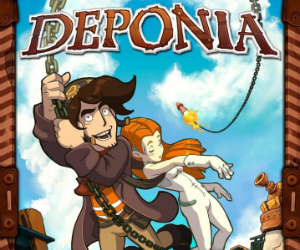 Game: Deponia
Game: Deponia
Developer: Daedalic Entertainment
Publisher: Lace Mamba Global
Available on: PC only
Germany has long been a hotbed for adventure gaming. Even in the golden age of the genre, in the late eighties and early nineties, when the graphic adventure was the most popular PC game worldwide, Germany always commanded huge levels of sales. When the genre experienced a decline, and development of titles waned, Germany took up the mantle and many small, independent designers set to work. One of these has been Daedalic, who already have a string of cult hits under their belt. With Deponia, the team is looking for a crossover hit that might manage to catch the attention of more than just the adventuring niche market.
STORY: Deponia is a planet that is almost entirely covered in junk. There are a few settlements scattered across the planet, such as Kuvac, where inhabitants live within the rubble and re-use and recycle the trash in order to build homes, entertain themselves and even source their food and supplies. Enter Rufus, a good-hearted scoundrel who plans to leave the planet and find a better life on Elysium, the interconnected planet where most of the trash comes from. Rufus was left on Deponia at a young age by his father, and this only further fuels the fire of his desire to get away and make better his life.
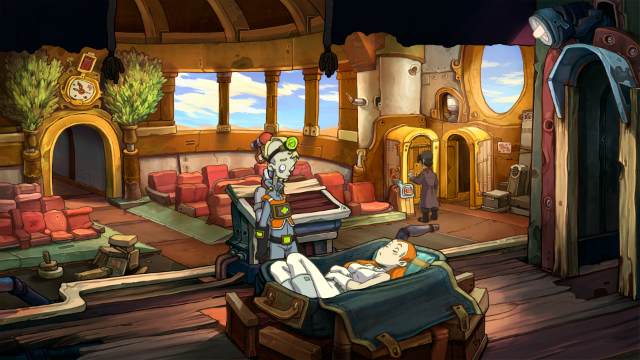
All of this takes a huge step closer to reality after another of his failed attempts to escape the planet leads to a beautiful Elysian woman, named Goal, falling from the sky, all the way down to Deponia. If he ever wants to reach Elysium himself, Rufus must find her and help her get home. However, he is hindered by the Organon, a group of cybernetically-enhanced goons who look a little like Darth Vader, but sound like Stewie Griffin. You must help protect Goal and uncover a conspiracy that threatens everyone on Deponia.
As with any good adventure game, story is paramount. The premise for Deponia is quite a simple one, striving for a better life, but it is played out well against the backdrop of the two differing civilisations; one privileged, one not. A lot of plot threads are raised, and along the way we learn of conspiracies and dodgy dealings that help raise the excitement levels, but this is unfortunately tempered by the sometimes haphazard translation from German. We are really left guessing at what the writers could have meant on occasions, as the translation team have either been too literal, or not clear enough, and the meaning is sometimes lost.This also results in the jokes becoming confused sometimes, although it does remain a funny, light-hearted game, with some genuine chuckles involved.
Another problem is Rufus, who comes across as somewhat of an unlikeable anti-hero, which may make relating to him difficult. I did find that as the game progresses, he develops a little and you become more fond of him, despite his faults. There is always a strong thrust to the game, in that you know what your objective is and what your motivations are, and this will keep you wanting to carry on; especially once the action hots up in chapter three.
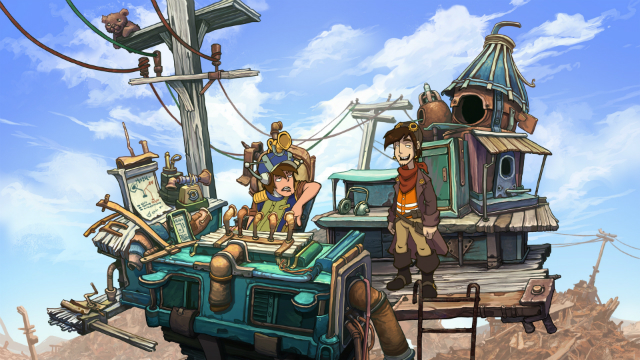
GRAPHICS: For an indie title with a relatively small production team, Deponia is a beautiful looking game. The high definition, hand-drawn visuals are super crisp and full of character, at times you could be forgiven for thinking you were watching a cartoon. They are animated fluidly, and even small in-game actions are afforded their own animation cycles. The cast of strange people is also hugely varied and interesting with some real individuals standing out as strong characters.
The design is also lovely to look at. The combination of the man-made junk environment and the natural skies and backdrops give the game a sort of old west charm with warm colours and fluffy clouds combining well with the haphazard, almost steampunk technology of the game. If you want to talk about the cutscenes – which are high-def, television quality cartoons – they are also a joy to watch. This game is really, incredibly good-looking.
SOUND: The music of Deponia also shares a certain beauty, where it combines junk and mechanical sounds with ambient, relaxing tunes that reflect the barren feeling of the planet. Tinny sounds and the crashing of metal, a’la musical group STOMP, make up the background music when in Kuvac, so you really get the feeling of a junk-filled world. Then there is the contrast when you are around Goal and other citizens of Elysium, and the music is much more ambient and futuristic sounding. The mix of the two sound styles, of course coupled with some more dramatic music for the action-packed sections, works quite effectively, and suits the game down to the ground.
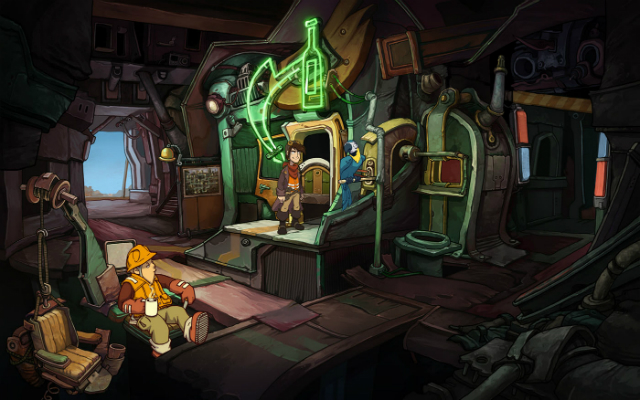
One thing you have to keep in mind somewhat when it comes to the voice acting in the game is that the script has all been translated from the original German language. This does result in some stilted and strange delivery of lines at times, when the make-up of the sentence or the arrangement of the words doesn’t make a great deal of sense but, regardless of that, the English-language voice actors do a very good job of making the most of the hand that they are dealt. The voices are well-suited to the individual characters, and help flesh out the personality of them effectively. A more thorough translation would have resulted in a slightly more comfortable listening experience as sometimes it is near-impossible to work out what the characters mean by what they say. However, this only happens occasionally, and unless you are looking for it, it shouldn’t influence your overall experience too much.
GAMEPLAY: The gameplay is very traditional in adventure gaming terms, simpler than most even, as you only have two icons to deal with. The left mouse button will control actions, picking up and speaking, whilst the right button is for examining items and your surroundings. It is that simple. There is also a simple inventory system, which is used quite frequently for inventory-based puzzles, where you combine items together to create the desired outcome, or use the items you have collected around the game world to manipulate objects. There are also a few conversation-based puzzles, where you will have to navigate dialogue trees and select the correct responses to get the desired result.
Aside from the aforementioned puzzles, there are a few special puzzle types. These include rotating tile puzzles, a lights-out type game and a very fiendish maze that will most likely leave you tearing your hair out. Fortunately, on all of these special puzzles there is a skip button, so if it starts to frustrate you too much you will be able to skip it and carry on with the game. This is a good option for amateur adventurers, who won’t want to spend ages on one puzzle but also allows more experienced puzzlers to challenge themselves more by making sure they don’t skip any of the harder ones.
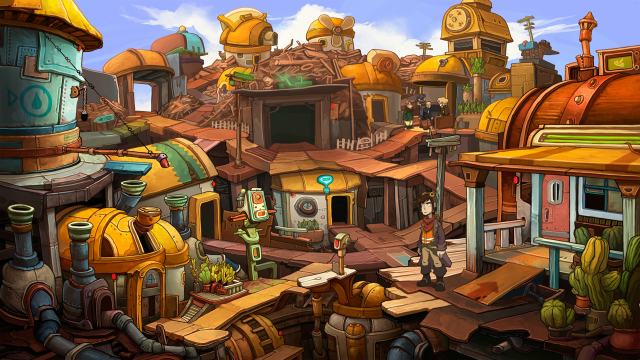
This is a good thing, as the game doesn’t have a built-in hint system, which is something that has become commonplace in modern adventure games. This isn’t a bad thing per se, as it does tend to over-simplify games, but it is a negative point if the company is trying to get new gamers involved in the game. People who aren’t seasoned adventurers will find this game rather difficult, as too many of the puzzles are completely illogical. That is the main criticism I could have of this title. Very few of the puzzles are logical jumps for the player, and this makes coming to the correct conclusion quite tough. This is even harder when a few in-game items are incorrectly translated, so when you point at the item it might not be called by the correct English name, so the puzzle solution won’t make sense. Without a hint system, I think there is a chance a lot of players could get well and truly stuck in this game. Which is a shame, as it is charming and well-designed.
LONGEVITY: The game length entirely depends on how long you will take to solve the bulk of the puzzles. I would say that the title would take most players around five to six hours to complete, with experienced players taking closer to three or four. As such, it is a relatively short title, as most graphic adventures tend to be. Due to the very linear nature of the game, there is no real re-play value. You could experience absolutely everything in the title with one thorough playthrough; and there is nothing really to encourage you to start it again. This is the first episode in a three-part story, and will leave you waiting for the next game, but it might not keep you busy for all that long.
VERDICT: Deponia is at once a stunning game to behold, in terms of visuals and audio, and also very confusing, especially for the uninitiated. The cartoon-quality graphics and great, atmospheric music will suck gamers in, but many will quickly become frustrated with the illogical puzzle solutions and sometimes broken English. The length is also somewhat of an issue, as it won’t keep you busy for long, but does serve as a good introduction to a new series and the world of the game. The interface is friendly and easy to pick up, and there is actually some real laughs in the script; if you can understand the translated jokes. You will want to find out what happens to Rufus and Goal, but you may well become irritated along the way.






